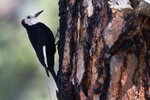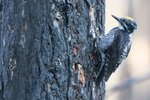




Introduction – In 2023 Liam Hutcheson located and documented 378 bird species in Washington, a new state record. I have asked Liam to write accounts of some of Washington's birding places that were essential to his Big Year success.
~ George Walter
With mid-April upon us, songbird migration is in full swing!
Warblers and flycatchers are trickling in, their songs filling the morning air. Nowhere is spring as evident as the eastern slopes of the Cascades. Within its Ponderosa Pine forests, the woodpeckers and grouse awake and join the new migrants.
Birds such as the Sooty Grouse, American Three-toed, Black-backed and White-headed Woodpeckers, and Mountain Chickadees are some of the specialties of the east slope, and with them one might find migrants such as the Dusky Flycatcher and Nashville Warbler.
This area hosts one of the highest woodpecker diversities anywhere in North America, with up to ten species possible in the right spots. Many of these are common in our own Thurston County and elsewhere in Washington, but three come to mind as eastern slope specialties – the American Three-toed Woodpecker, Black-backed Woodpecker and the White-headed Woodpecker. Three-toed and Black-backed are similar species, robin-sized black and white woodpeckers with yellow crowns and pale underparts. The Three-toed has some white striping on the back, whereas the Black-backed, as its name suggests, does not. They are usually seen clinging to trees.
The Black-backed Woodpecker is an especially interesting bird, relying heavily on burned forests where they are seen creeping up the charred bark peeling flakes off in search of insects. Three-toed are also common in a burned environment, although less so than the Black-backed. So, while you are hunting for morel mushrooms in these recently burned areas, keep you eye out for these woodpecker specialists.
The White-headed Woodpecker is another appropriately named species, with both sexes sporting a glossy black body with a bright white head! Also robin-sized, they are more common in live forests than burned ones and seem to favor Ponderosa Pine heavily. These birds are unmistakable! All three species have a sharp, pitik or pwik call, alerting you to their nearby presence.
As you walk through the forested east slope foothills in search of woodpeckers, you may hear a very interesting and not especially bird-like noise – a very low-pitched and soft hooting call, “whoo, whoo, whoo, who, who.” This is the call of the Sooty Grouse. Males of this species perch high in conifers, emitting a series of these hooting noises, often every thirty seconds or so. If you are lucky enough to spot one of these displaying birds, you might see its bright yellow air sacks inflate on each side of the neck with each call.
Sooty Grouse are closely related to the Dusky Grouse and, until quite recently, they were lumped under one species, the “Blue Grouse.” Both species are possible in the eastern cascades, with Dusky found exclusively north of Snoqualmie pass and favoring the farthest east dryer slopes. Sooty are found through the entire Cascades, and Olympics as well. Dusky Grouse are especially prevalent around Leavenworth and the Methow Valley, in the latter location there is quite a bit of range overlap between the Sooties and the Duskies.
These two species are very similar and only separable by the color of the displaying males’ air sack, red in Dusky and yellow in Sooty. Sooty males usually display from trees, while Dusky males prefer the ground, although I have observed male Dusky Grouse in trees also. As for female and immature birds, they are virtually inseparable and, in areas of overlap, are best left unidentified. The area west of the Cascade crest and the Olympics is exclusively Sooty Grouse territory, and in the Blue Mountains and the northeastern part of the state, only Duskies are found.
In the canopies above the grouse and woodpeckers, you might hear the call of a different type of chickadee, the Mountain Chickadee. Its call is often described as sounding like a hoarse version of our regular westside chickadees. Mountain Chickadees also look different; they’re chunkier with bold white eyebrows. Along with the chickadees, you might find Cassin's Finches, the eastern slope version of our common Purple Finch. They are quite similar in appearance, but males have a bolder reddish-peaked head.
Along with these year-round residents, you might find one or more of our new migrants. Nashville Warblers light up the understory with their yellow bodies and gray heads and can also be identified by the males’ unique song. Dusky flycatchers, however, pose a serious identification challenge as they look very similar to other small flycatchers.
Finally, in the burns and clearings, there are likely to be House Wrens bursting into song with their characteristic warbles and trills. And you may encounter Western or Mountain Bluebirds hunting insects from low perches. Spring is an amazing time, and the eastern slopes of the Cascades will never disappoint!
George Walter usually writes the THURSTON'S BIRDS column. He is environmental program manager at the Nisqually Indian Tribe’s natural resources department; he also has a 40+ year interest in bird watching. He may be reached at george@theJOLTnews.com
Photos for this column are provided by Liam Hutcheson, a 16-year-old Olympia area birder and avid photographer.
2 comments on this item Please log in to comment by clicking here
Bigjules
Yay Liam!
Friday, April 19 Report this
Callie
Thank you
Wednesday, April 24 Report this